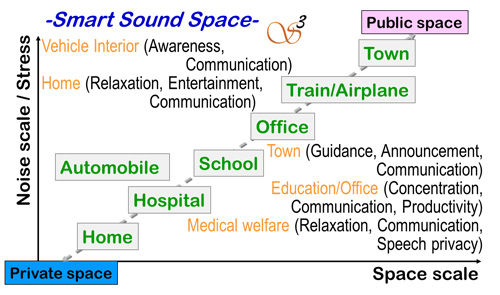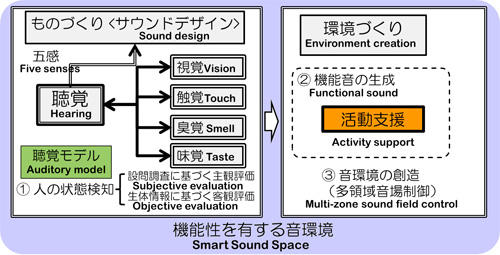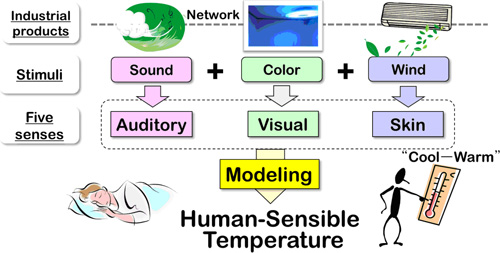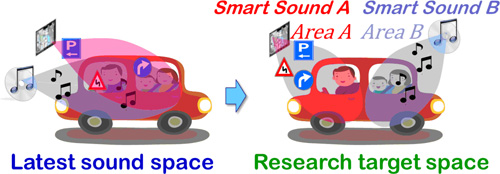Top>Research>Research for the creation of smart sound spaces
 Index
Index

Akihiko Arimitsu [profile]
Research for the creation of smart sound spaces
Akihiko Arimitsu
Assistant Professor, Faculty of Science and Engineering, Chuo University
Area of Specialization: Acoustical Engineering
1. Introduction
Conventionally, the main interest in sound environments has been auditory discomfort which has a psychological and biological effect on human beings. It is also a known fact that our daily activities and mental state are affected by sound environments.
In terms of mechanical products, texture-related research which considers sensibility is being performed in conjunction with improved design that appeals to all of the five senses, including hearing and sight. Generally speaking, sensibility including auditory sensation is viewed as follows: “The information flow until emotional expression (psychological reaction) which is caused after an external stimulus is perceived by the sense organs of a person, as well as the associated physiological reaction.” Therefore, the ideal design and environment can be constructed through evaluation of human psychological reactions and physiological reactions.
Auditory sensation is linked with the other human senses including visual sensation (the color, shape, etc. of the mechanical product) and tactile sensation (naturalness and comfort of wind stimulus, etc.). Psychological reactions and physiological reactions are known to change according to each of the five senses. Therefore, in the case of spaces composed of mechanical products which stimulate the five senses, it is preferable to create a sound environment that considers reciprocal influence of the five senses, instead of just the auditory sense alone. Stated another way, people have a diverse variety of purposes for their activities in each space, and it is expected that these activities can be supported by using the sound environment to control psychological reactions and physiological reactions.
2. Construction of a smart sound space

Figure 1: Overview of sound environment functionality in target space
I seek to construct a functional sound environment (hereinafter referred to as a “smart sound space”) based on activity purposes such as increasing comfort or improving intellectual productivity in target spaces consisting of private spaces (homes, automobiles, medical facilities, etc.) and public spaces (schools, workplaces, stations, towns, etc.). (Figure 1) For example, at medical facilities including university hospitals, I conducted a large-scale questionnaire survey regarding sound environments for patients and medical workers. The survey indicated the need for sound environments which are appropriate for the purpose of positions and spaces.
As shown in Figure 2, a control method which considers interaction of the human five senses (including auditory sensation) and which support activities in a wide range of zones is required for the construction of a smart sound space. Accordingly, I use subjective evaluation technology based on questionnaire surveys as psychological reactions, objective analysis technology based on biological information as physiological reactions, and multi-zone sound field control technology.
Furthermore, a significant contribution to activity support can be realized by focusing on the following three aspects shown in Figure 2. First is “(1) Monitoring the human state.” Specifically, the mechanism of psychological reactions and physiological reactions to a sound environment is constructed as an auditory model. Next, in “(2) Functional sound,” appropriate functional sound for a sound environment is generated using an auditory model which considers the interaction of the human five senses, including auditory sensation. In “(3) Creation of sound environment,” multi-zone sound field control is used to construct a sound environment for purposes in multiple zones. Construction considers photic stimulation such as color and wind stimulation such as breezes.
Next, I will explain practical examples of this research.

Figure 2: Overview of constructing a smart sound space
3. Sound design which integrates auditory and visual senses
In recent years, there has been an increase in color design options for home appliance exteriors, automobile bodies, and automobile interior trim. Accordingly, there is the need for sound design to realize product sound which is appropriate for color design. Applied research for sound design which considers sensibility has demonstrated the need to consider the interaction of auditory and visual senses when creating a sound environment.
First, I reviewed how auditory sensation is impacted by visual sensation using the color of objects. Next, in order to propose sound design which is appropriate for the image created by automobile body color, I developed an audiovisual sensation model which uses objective evaluation to express the relationship between body color and operation sound. I then used the model to review the interaction between auditory sensation and visual sensation. As a result, I demonstrated an image evaluation of stateliness, clarity and comfort for both the color and operation sound of objects. Also, by conducting an audiovisual sensation matching test, I clarified that an appropriate relationship exists between color and operation sound. I also discovered that sound design which integrates auditory sensation and visual sensation is capable of reducing stress through a physiological reaction.
The brightness of color impacts the image of sound stateliness, while the saturation of color impacts the image of sound clarity. Furthermore, an inverse trend was observed between the clarity of color and the comfort of sound. Considering these trends makes it possible to design sound appropriate for the color.
4. Creation of a sound environment which integrates auditory sensation and other human senses

Figure 3: Overview of sound environment using multi-zone sound field control
As applied research, I devised a smart sound space which considers the interaction of auditory sensation and the other human senses. My research focused on providing support for relaxing in daily life and support for inducing sleep during rest time prior to falling asleep. In an environment set to a standard temperature which envisions an air-conditioned environment during summertime, I reviewed the impact of composite stimulus on sensible temperature. Specifically, in addition to the sound environment when blowing air, my research also considered the color environment. I construct an audiovisual model from a subjective evaluation based on a questionnaire survey and an objective evaluation based on physiological information. As a result, it is possible to construct a functional sound environment which is capable of controlling sensible temperature.
First, I surveyed how sensible temperature is impacted by a sound environment. The high-frequency band components included in the sound of blowing air induce a cool feeling in people. There is an appropriate frequency band which possesses feeling of both comfort and coolness. Moreover, there is a linear relationship between the frequency band and feeling of coolness. It is possible to create an auditory model for sensible temperature using the sharpness of acoustic psychological evaluation amount.
Next, I surveyed how sensible temperature is impacted by the color environment. Subjective evaluation indicates that bright colors within the color environment possess a feeling of coolness and induce sleep. Sensible temperature is impacted by the chromaticity x component shown in the xy chromaticity diagram. It is possible to use chromaticity x to construct a visual model based on the relationship between the chromaticity diagram and sensible temperature. Moreover, the impact of color environment on sensible temperature was ±1℃, which is roughly equivalent to the impact of a sound environment.
I also combined a sound environment and color environment in order to survey how sensible temperature is impacted by composite stimulus. It is now possible to effectively change sensible temperature through simultaneous consideration of a sound environment and color environment which had a significant impact on feelings of coolness and warmth.
In recent years, researchers have succeeded improving feelings of comfort and naturalness in a wind environment realized by using air conditioning equipment. Through composite control together with a sound environment and color environment, these findings can be applied to smart houses and automobile interiors in addition to home appliances.
5. Multi-zone sound field control for smart sound space

Figure 4: Overview of sound environment using multi-zone sound field control
As explained above, multiple zones are used to construct sound environments which are appropriate for the purposes of people. Figure 4 shows an overview of the sound environment which is created through “multi-zone sound field control” which controls the sound environment in the multi-zones of automobile interiors. Through advancements in semiconductors, an increasing number of automobiles are equipped with premium audio systems which consist of more than ten speakers. As shown in the left-hand side of Figure 4, these systems provide the virtual musical experience of having front-row seats at a concert of live musical performance. Sound environments featuring outstanding sound quality, localization and depth have been created using equalizing with digital filters. Furthermore, although audio guidance of the navigation system is also transmitted to all passenger seats, such audio guidance is unnecessary audio information for sleeping children. In such a case, the sound environment should not transmit the information.
On the other hand, driving of automobiles will be automated in the near future. The activities of the drivers and passengers riding in vehicles will become increasingly diversified, and there will be the need for personal sound environments dedicated to individuals in multi-zones. Therefore, it is necessary to develop the control method for a sound environment which can transmit smart sound to individual seats of the driver and passengers. This smart sound must ensure comfort, the safety of arousing the driver when drowsy, and the ability to improve maneuverability. The provision of a sound environment which is appropriate for the psychological and physiological conditions of the driver and passenger will be an essential part of automobile interiors in the future. Growth is expected in applied fields.
Accordingly, I applied the theory of multi-zone sound field control to automotive interiors and reviewed a method for effective transmission of sound information to control zones of the driver and passenger. For the target sound field around the heads of passengers, when providing specific sound pressure distribution such as transmission fields and non-transmission fields for smart sound, digital filters are an effective method of guiding sound to the target sound field. First, I place a frame equipped with a microphone in the vehicle interior. I then measured the acoustic transmission function with multiple speakers in the two zones of the driver’s seat and rear passenger seat. Next, I used the acoustic transmission function to determine a speaker position for effective transmission of audio information. I also reviewed the use of digital filters for the target sound field and effective output methods. As a result, I determined that it is possible to construct target sound fields in multiple zones. When applying these findings to a luxury sedan equipped with a 16-channel premium audio system, I was able to obtain the target sound field by changing the position of some speakers.
In addition to automobiles, this technology can be applied to homes and other closed environments.
6. Conclusion
The ultimate purpose of my research is to constantly provide appropriate support for activities based on personal auditory models in environments where people are present. Significant contribution to supporting human activities can be realized by using subjective evaluation technology based on questionnaire surveys, objective analysis technology based on biological information, and multi-zone sound field control technology in order to construct sound field control methods from the perspectives of (1) monitoring the human state, (2) functional sound, and (3) creation of sound environment.
In the future, the environment will advance through cooperation between people and the environment. Someday, it will become possible to provide a sustainable sound space which has a continuous effect on support activity for humans.
- Akihiko Arimitsu
Assistant Professor, Faculty of Science and Engineering, Chuo University
Area of Specialization: Acoustical Engineering - Akihiko Arimitsu was born in Kanagawa Prefecture in 1974.
In 1998, he graduated from the Department of Precision Mechanics, Faculty of Science and Engineering, Chuo University.
In 2000, he completed the Master’s Program in Precision Engineering at the Graduate School of Science and Engineering, Chuo University. In the same year, he entered employment at Sony Corporation. His work responsibilities included research on sound/video signal processing technology for the creation of new businesses. He participated in an automotive system project (sound system) with an American automaker.
In 2014, he completed the Doctoral Program in Precision Engineering at the Graduate School of Science and Engineering, Chuo University. He holds a PhD in engineering. In the same year, he won the Graduate School Research Incentive Award from the Society of Automotive Engineers of Japan. He also won the Chairman’s Prize of the Chuo University Alumni Association.
He assumed his current position of Assistant Professor in 2014. In 2015, he won the 65th Best Paper Award from the Society of Automotive Engineers of Japan. He currently conducts “research on creation of functional sound environment for human activity support in consideration of integrated sensation,” with the goal of transforming automobiles and homes into smart sound spaces. Also, he conducts research on rowing science together with the Chuo University Rowing Team.
His hobby is rowing.
- Research Activities as a Member of Research Fellowship for Young Scientists (DC1), Japan Society for the Promotion of Science (JSPS) Shuma Tsurumi
- Important Factors for Innovation in Payment Services Nobuhiko Sugiura
- Beyond the Concepts of Fellow Citizens and Foreigners— To Achieve SDGs Goal 10 “Reduce Inequality Within and Among Countries” Rika Lee
- Diary of Struggles in Cambodia Fumie Fukuoka
- How Can We Measure Learning Ability?
—Analysis of a Competency Self-Assessment Questionnaire— Yu Saito / Yoko Neha - The Making of the Movie Kirakira Megane








